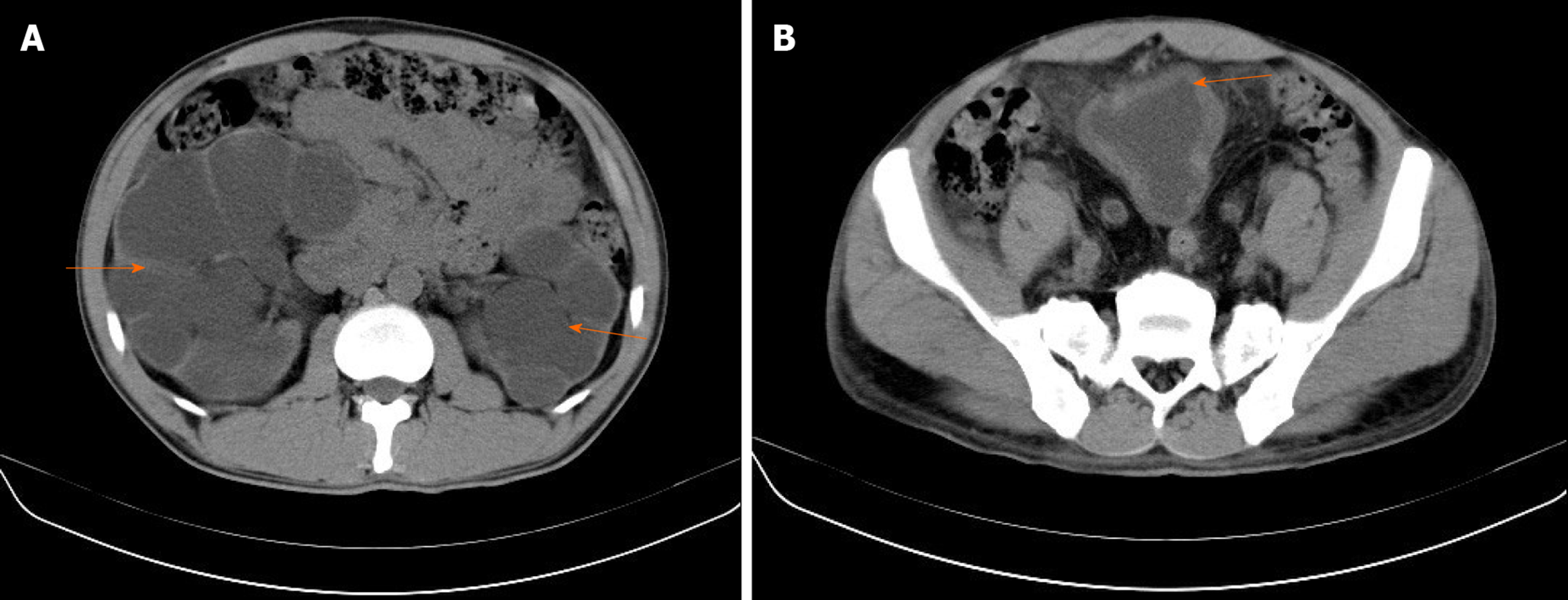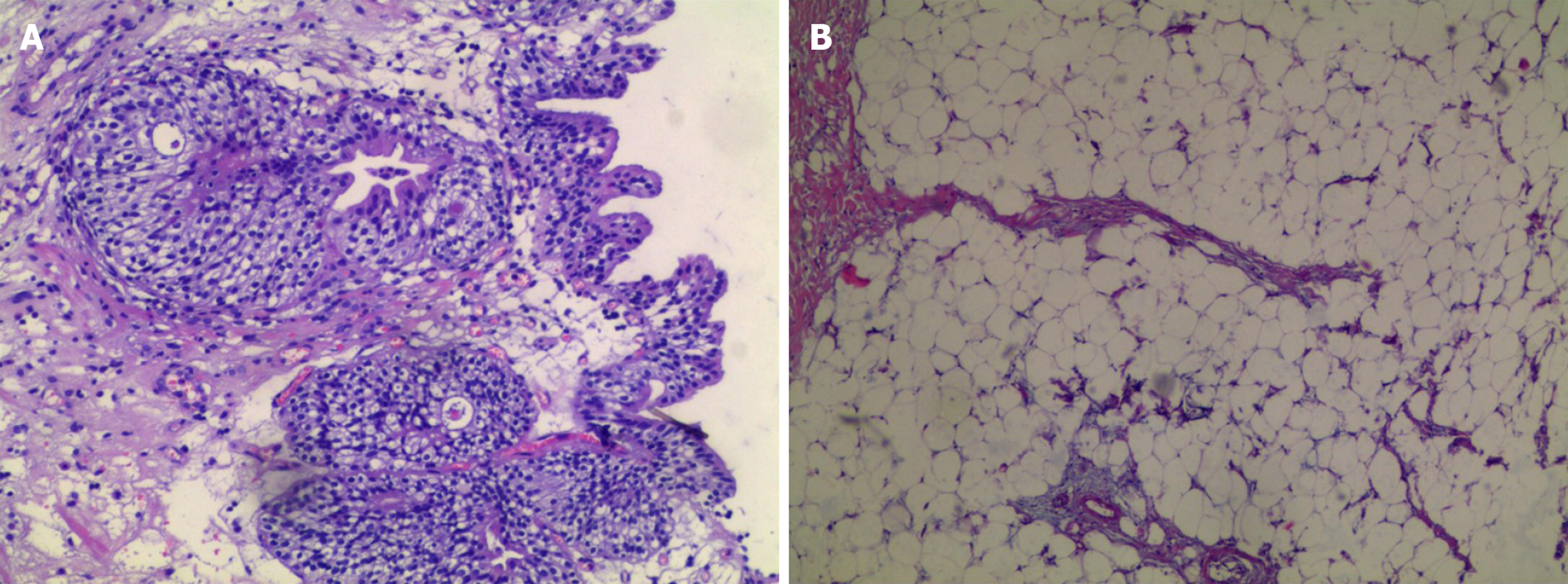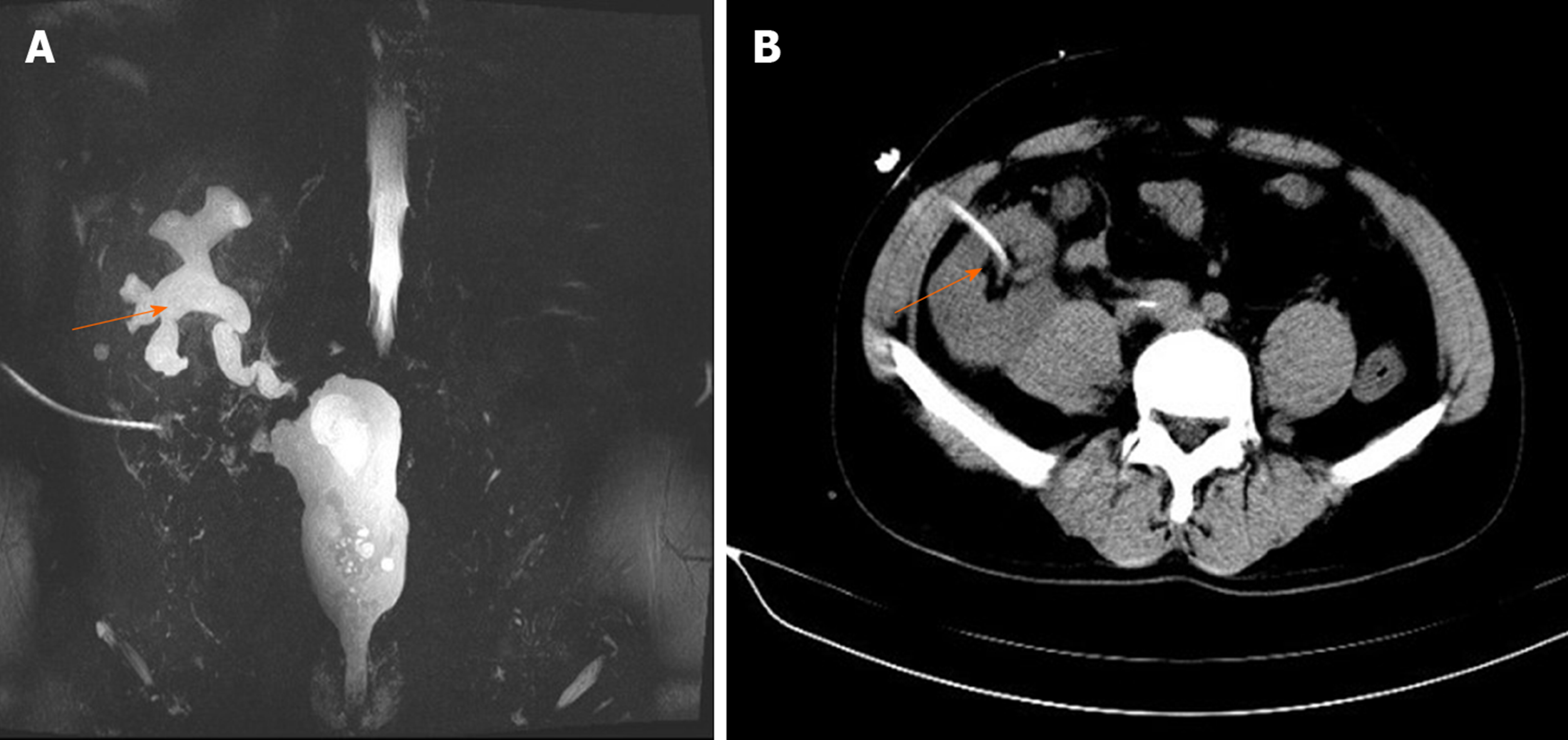Published online Aug 26, 2020. doi: 10.12998/wjcc.v8.i16.3548
Peer-review started: April 6, 2020
First decision: April 24, 2020
Revised: May 1, 2020
Accepted: July 16, 2020
Article in press: July 16, 2020
Published online: August 26, 2020
Processing time: 140 Days and 18.4 Hours
Pelvic lipomatosis is a rare disease of unknown etiology, characterized by the overgrowth of pelvic adipose tissue that causes compression of the urinary tract including the bladder and ureters, rectum and blood vessels. The patient may progressively develop obstructive uropathy which could subsequently lead to renal failure. At present, there are no reports of renal transplantation due to uremia caused by pelvic lipomatosis. The ideal management of patients with pelvic lipomatosis after renal transplantation is not yet well-established due to the lack of literature and follow-up data.
We report a 37-year-old male patient with pelvic lipomatosis who received a successful living donor renal transplantation on July 22, 2015. The operation was complicated as the iliac vessels and bladder were wrapped entirely in excessive abnormal fat. The external iliac artery and vein were located using ultrasonographic guidance. The adipose tissue around the right bladder was removed as far as possible, and the graft ureter was reimplanted into the bladder, using the Lich-Gregoir technique. At 22 mo after transplantation, graft percutaneous nephrostomy was performed under ultrasonographic guidance for urinary diversion due to hydronephrosis of the graft kidney. Follow-up at four years showed that the renal allograft function was stable.
When patients with pelvic lipomatosis develop renal failure, renal transplantation could be a feasible treatment strategy.
Core tip: We describe a patient with pelvic lipomatosis who underwent renal transplantation due to uremia. Such patients may progressively develop obstructive uropathy which can subsequently lead to renal failure. At present, there are no reports of renal transplantation due to uremia caused by pelvic lipomatosis. The ideal management of patients with pelvic lipomatosis after renal transplantation is not yet well-established due to the lack of literature and follow-up data.
- Citation: Zhao J, Fu YX, Feng G, Mo CB. Pelvic lipomatosis and renal transplantation: A case report. World J Clin Cases 2020; 8(16): 3548-3552
- URL: https://www.wjgnet.com/2307-8960/full/v8/i16/3548.htm
- DOI: https://dx.doi.org/10.12998/wjcc.v8.i16.3548
Pelvic lipomatosis is a rare disease of unknown etiology, characterized by the overgrowth of pelvic adipose tissue that causes compression of the urinary tract including the bladder and ureters, rectum and blood vessels[1]. These patients progressively develop obstructive uropathy, and 40% deteriorate into renal failure after an average period of five years[2-4]. At present, there are no reports of renal transplantation due to uremia caused by pelvic lipomatosis. The bladder and iliac vessels are entirely wrapped in this abnormal fat, making it difficult to dissociate iliac vessels and bladder during renal transplantation. Urinary tract obstruction may occur again after renal transplantation. The ideal management of patients with pelvic lipomatosis after renal transplantation is not yet well-established due to the lack of literature and follow-up data. Here, we report a 37-year-old male patient with pelvic lipomatosis who received a successful living donor renal transplantation.
A 37-year-old male patient presented to our hospital with complaints of fatigue and vomiting for two weeks on November 18, 2014.
On admission, a computed tomography (CT) scan showed bilateral severe hydronephrosis and a compressed and thick-walled bladder and extra fat tissues in the pelvis (Figure 1). The patient underwent cystoscopy, which showed an elongation of the prostatic urethra and elevation of the bladder neck. There were several bullous lesions over the wall of the neck and the trigone of the bladder. The bilateral ureteral orifices were not identified. A double “J” ureteral stent could not be placed appropriately. Tissue biopsy of the bladder demonstrated cystitis glandularis (Figure 2A). Bilateral percutaneous nephrostomy was performed under ultrasonographic guidance. Anterograde urography revealed bilateral hydronephrosis and tortuous dilated ureter, symmetrical compression and elevation of the bladder (a pear-shaped bladder) (Figure 3). Thus, a diagnosis of pelvic lipomatosis was confirmed. Despite an output of 1000-1500 mL urine in 24 h, renal function did not improve. The patient was diagnosed with end-stage renal disease and underwent hemodialysis.
He also had a history of persistent suprapubic pain and nocturia (2-3 times) for more than four years and a single episode of gross hematuria.
On admission, his height was 170 cm and weight was 71 kg, with a body mass index of 24. The physical examination revealed a palpable suprapubic mass and mild edema of both lower legs.
His serum creatinine was 1500 µmol/L and hemoglobin was 79 g/L.
Anterograde urography revealed bilateral hydronephrosis and tortuous dilated ureter, symmetrical compression and elevation of the bladder (a pear-shaped bladder) (Figure 3).
End-stage renal disease, pelvic lipomatosis, hydronephrosis.
Bilateral nephrectomy and living donor renal transplantation (kidney obtained from his brother) were performed on July 22, 2015. The operation was complicated as the iliac vessels and bladder were completely wrapped in excessive abnormal fat. The external iliac artery and vein were located using ultrasonographic guidance. The adipose tissue around the right bladder was removed as far as possible, and the graft ureter was reimplanted into the bladder, using the Lich-Gregoir technique. Histopathological examination of the fat showed a benign lipomatous lesion (Figure 2B). The double “J” stents were removed three months after the operation. Serum creatinine was 120 µmol/L after transplantation.
At six months postoperatively, mild hydronephrosis in the graft kidney was identified by magnetic resonance urography (Figure 4A), and graft function was stable. However, B-ultrasound showed moderate hydronephrosis at 22 mo after transplantation. Graft percutaneous nephrostomy was performed under ultrasonographic guidance for urinary diversion (Figure 4B). During the four-year follow-up period, the patient was in a stable condition and serum creatinine was 121 µmol/L.
Pelvic lipomatosis is a rare condition defined as a non-malignant overgrowth of normal fat in the pelvis. It was previously reported that the incidence of pelvic lipomatosis was 0.6-1.7 per 100000 hospital admissions in the United States[5]. Clinical manifestations are due to various compression phenomena spanning the rectum (constipation, tenesmus), the urinary tract (lower urinary tract symptoms), and venous structures (lower limb edema and thrombosis). The best definitive diagnostic procedure is CT, which demonstrates increased adipose tissue surrounding the bladder and rectum. A pear-shaped bladder and hydronephrosis are common findings on the CT urogram and are important characteristic indications of pelvic lipomatosis[2].
However, the etiology of pelvic lipomatosis is unknown. To date, various methods to treat pelvic lipomatosis, including steroids, long-term antibiotics, weight reduction, and radiation therapy have been proven to be ineffective[1]. The recommended management strategy includes close monitoring of the development and progression of hydronephrosis and renal function. When obstruction develops, an appropriate diversion can be performed by ureteral reimplantation, nephrostomy, ureterostomy or a conduit[6]. Klein et al[7] reported that urinary diversion was eventually required in 39% of patients during a 7.5-year follow-up period[7]. The surgical removal of adipose tissue surrounding the bladder does not lead to a radiological abnormality or remission of the condition[8].
When bilateral hydronephrosis progresses, 40% of patients deteriorate into renal failure after an average period of five years and kidney transplantation can be considered. Even though excision of the pelvic fat and dissection of adhesions of the external vessels and bladder may be difficult, transplantation is not entirely impossible. Reconstruction of the urinary tract can be considered according to conventional ureteral bladder replantation. The recurrence of graft urinary obstruction associated with pelvic lipomatosis is also possible. However, there are no literature reports on the recurrence of ureteral obstruction after renal transplantation. The recommended management strategy includes close monitoring of the graft renal function, and if progression due to obstruction is observed, urinary diversion should be considered.
We are also concerned that the graft renal vein and external iliac vein may be compressed by excess adipose tissue after the operation, leading to thrombosis. Currently, there are several reports of deep venous thrombosis in patients with pelvic lipomatosis[9-11]. Schechter[9] reported a patient with venous thrombosis of the left iliac vein as a result of pelvic lipomatosis. Therefore, we administered aspirin to prevent venous thrombosis, and no thrombosis was found during the follow-up period.
When patients with pelvic lipomatosis develop renal failure, renal transplantation could be a feasible treatment strategy.
Manuscript source: Unsolicited manuscript
Specialty type: Medicine, research and experimental
Country/Territory of origin: China
Peer-review report’s scientific quality classification
Grade A (Excellent): A
Grade B (Very good): 0
Grade C (Good): C
Grade D (Fair): 0
Grade E (Poor): 0
P-Reviewer: Granata A, Pham PTT S-Editor: Zhang L L-Editor: Webster JR P-Editor: Liu JH
| 1. | Heyns CF. Pelvic lipomatosis: a review of its diagnosis and management. J Urol. 1991;146:267-273. [RCA] [PubMed] [DOI] [Full Text] [Cited by in Crossref: 41] [Cited by in RCA: 32] [Article Influence: 0.9] [Reference Citation Analysis (0)] |
| 2. | Xia S, Yan Y, Peng B, Yang B, Zheng J. Image characteristics of computer tomography urography in pelvic lipomatosis. Int J Clin Exp Med. 2014;7:296-299. [PubMed] |
| 3. | Golding PL, Singh M, Worthington B. Bilateral ureteric obstruction caused by benign pelvic lipomatosis. Br J Surg. 1972;59:69-72. [RCA] [PubMed] [DOI] [Full Text] [Cited by in Crossref: 25] [Cited by in RCA: 24] [Article Influence: 0.5] [Reference Citation Analysis (0)] |
| 4. | Crane DB, Smith MJ. Pelvic lipomatosis: 5-year followup. J Urol. 1977;118:547-550. [RCA] [PubMed] [DOI] [Full Text] [Cited by in Crossref: 27] [Cited by in RCA: 22] [Article Influence: 0.5] [Reference Citation Analysis (0)] |
| 6. | Miglani U, Sinha T, Gupta SK, Doddamani D, Sethi GS, Talwar R, Agrawal S, Chandra M, Rana YP, Harkar S. Rare etiology of obstructive uropathy: pelvic lipomatosis. Urol Int. 2010;84:239-241. [RCA] [PubMed] [DOI] [Full Text] [Cited by in Crossref: 9] [Cited by in RCA: 11] [Article Influence: 0.7] [Reference Citation Analysis (0)] |
| 7. | Klein FA, Smith MJ, Kasenetz I. Pelvic lipomatosis: 35-year experience. J Urol. 1988;139:998-1001. [RCA] [PubMed] [DOI] [Full Text] [Cited by in Crossref: 37] [Cited by in RCA: 28] [Article Influence: 0.8] [Reference Citation Analysis (0)] |
| 8. | Prabakaran R, Abraham G, Kurien A, Mathew M, Parthasarathy R. Pelvic lipomatosis. Kidney Int. 2016;90:453. [RCA] [PubMed] [DOI] [Full Text] [Cited by in Crossref: 3] [Cited by in RCA: 3] [Article Influence: 0.4] [Reference Citation Analysis (0)] |
| 9. | Schechter LS. Venous obstruction in pelvic lipomatosis. J Urol. 1974;111:757-759. [RCA] [PubMed] [DOI] [Full Text] [Cited by in Crossref: 19] [Cited by in RCA: 19] [Article Influence: 0.4] [Reference Citation Analysis (0)] |
| 10. | Locko RC, Interrante AL. Pelvic lipomatosis. Case of inferior vena caval obstruction. JAMA. 1980;244:1473-1474. [RCA] [PubMed] [DOI] [Full Text] [Cited by in Crossref: 2] [Cited by in RCA: 4] [Article Influence: 0.1] [Reference Citation Analysis (0)] |
| 11. | Sercan Ö. Pelvic lipomatosis associated with portal vein thrombosis and hydronephrosis: a case report. J Int Med Res. 2019;47:2674-2678. [RCA] [PubMed] [DOI] [Full Text] [Full Text (PDF)] [Cited by in Crossref: 2] [Cited by in RCA: 3] [Article Influence: 0.5] [Reference Citation Analysis (0)] |












